The Cereus Fund of Trees Foundation Continues to Help Grassroots Environmental Advocacy in the Redwoods Region

The following pages highlight grassroots environmental projects supported by the Cereus Fund of Trees Foundation in 2021. Established in 1998, the Cereus Fund is a part of Trees Foundation’s Donor Advised Program which allows individuals to donate and direct funding to projects of their choice, which Trees Foundation administers on their behalf. To learn more about these projects, or to start a Donor Advised Fund of your own, email [email protected].
Trees Foundation is deeply grateful for this 23rd year of generous and enduring support from the Cereus Fund.
Bay Area Coalition for Headwaters
By Karen Pickett
Necessity may be the mother of invention, but its sister is creativity. As some pandemic limitations persist, all around us dedicated tree-huggers, forest lovers, and habitat defenders are rolling out creative solutions for keeping on with the work.
Continuing to serve those on the front lines on the North Coast in 2021, BACH bounced out news, information, and photos to our mainstream media lists and to Bay Area networks that generated letters to agencies and organizations and stories online, in print, and on the air. Issues included:
- Jackson Demonstration State Forest (JSDF) stepped-up logging plans, with threats to forest protectors;
- Caltrans trying—again—to resurrect its boondoggle highway expansion project through Richardson Grove State Park;
- PG&E bringing extreme and unnecessary measures into Humboldt Redwoods State Park (HRSP) in the name of fire safety improvement, including plans to cut large, old trees;
- Mendocino County Museum’s exhibit of the attempted assassination of Judi Bari in the car bomb attack 31 years ago; and more.
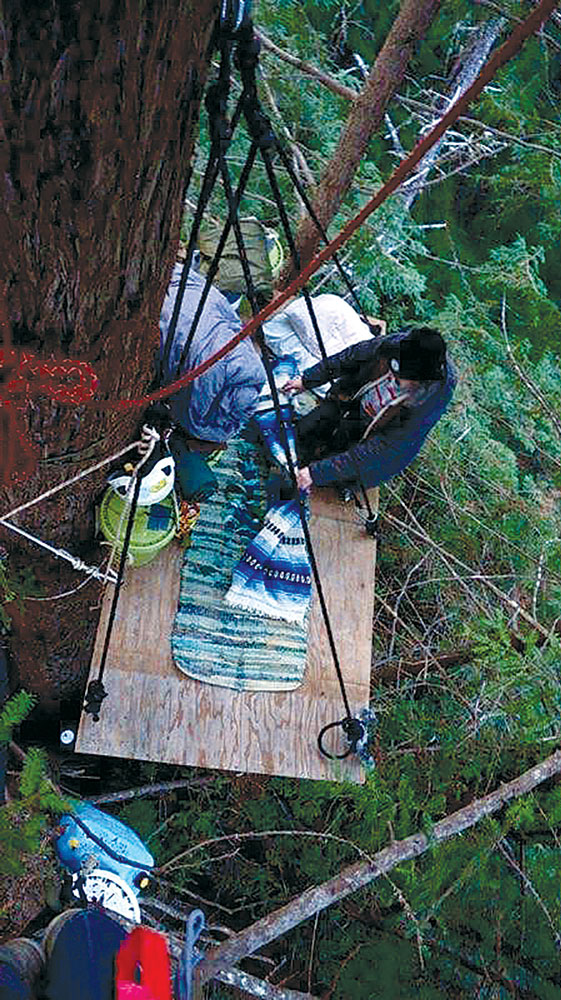
photo by the Mama Tree Network
The current attention on exploitation of publicly-held forests, like JDSF and HRSP, has generated renewed interest from both populations outside the “redwood curtain” and from media. It points to a mounting awareness of the forest-climate connection, as hammered home in many of our press releases. There exists a particular kind of outrage over exploitation of public resources, ostensibly outside the reach of capitalism’s profit motive.
We have also been studying language, in a manner of speaking, participating in anti-racism workshops specific to the environmental movement, and allyship discussions with those from other campaigns around the continent to help in crafting language that honors the diversity of people working for biological diversity. What we learn from these discussions feeds into press releases and other outreach materials—that’s where the rubber hits the road in recognizing the importance of how we use language as a tool.
Throughout 2021, we have written, edited, and proofread many historical accounts, analyses of the evolution of ecological organizing, as well as press releases and public outreach materials. We also participated in strategy discussions and tactics analyses in order to bring as many minds as possible to decisions about actions taken around the issues of climate and forests, including lending support to youth-led climate actions this fall.
We look forward to setting up media workshops and discussions with campaigns in person soon, in appropriately safe mediums and locations, and are initiating discussions around that. Many thanks to Trees Foundation’s Cereus Fund for supporting our work!
Eel River Recovery Project
Creative Outreach Using the Cereus Fund Grant
By Pat Higgins
The Eel River Recovery Project (ERRP) was frustrated when the pandemic stopped public meetings, so we decided to use this year’s Cereus Fund grant from Trees Foundation to fund creative outreach. After buying a Zoom subscription, we held two Eel Zoom series in spring and fall 2021. In addition, ERRP created a new program on KYBU radio, The Harmony Half Hour, in Covelo with the assistance of Sirius Studios in Eureka.
The first Eel Zoom series ran from April 2 through May 28 on Friday nights at 5 pm. This Happy Hour time slot targets folks ready for a libation at the end of the week with presentations that are informative yet informal. The series started with ERRP Managing Director and fish biologist Pat Higgins presenting on the “Status of Eel River Salmon and Steelhead.” Other topics covered were Sacramento pikeminnow management, water temperature and flow, salmon parks, forest health, and toxic cyanobacteria. Highlights included Eli Asarian explaining why Eel River flows have decreased over time, and how we could restore them. Thomas Keter batted last and provided a comprehensive history of the North Fork Eel River watershed that covered 10,000 years and a number of different disciplines in a breezy style.
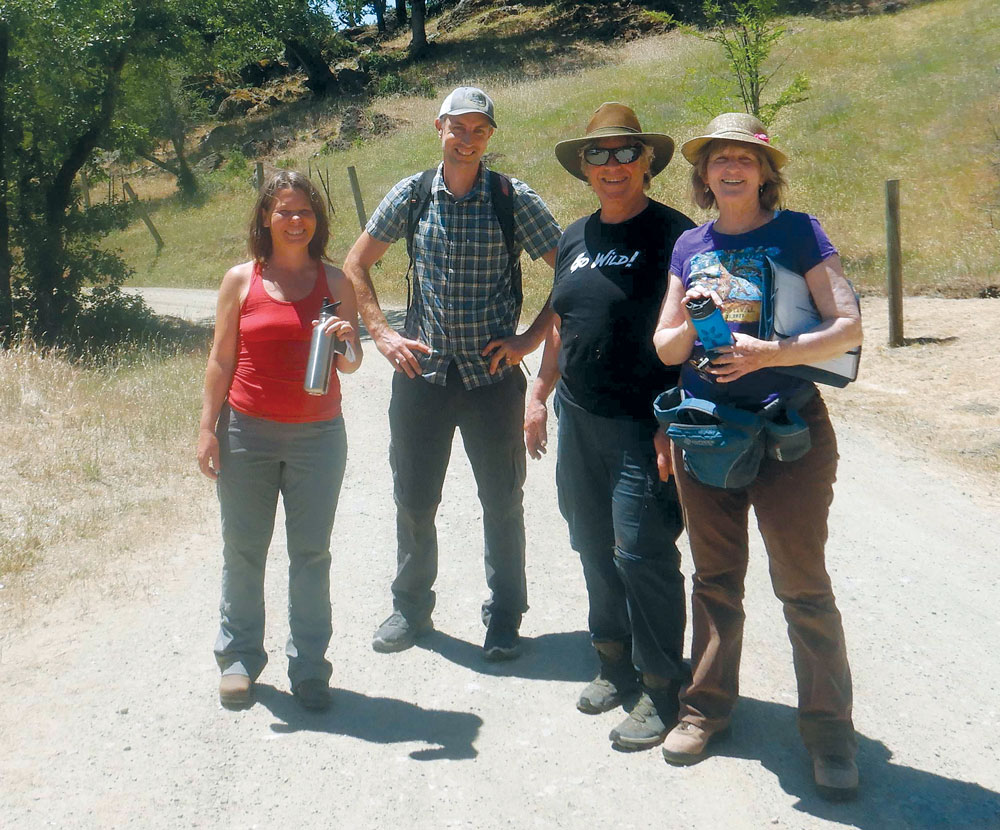
Anna Birkas (l), Joel Monschke of Stillwater Sciences, Pat Higgins, and Teri Jo Barber assessing gullies on the Vassar property in lower Tenmile Creek.
Photo courtesy ERRP
Eel Zoom II began on October 15, again on Friday at 5 pm, with Tom Keter recounting the effects of the August Fire on the North Fork Eel River watershed and sacred sites therein. “Speeding Forest Health Implementation on the North Coast” was the second in the series on October 22, when Pat Higgins was joined by Tim Bailey of the Hayfork Watershed Center. Other Eel Zoom II topics include restoring native grasses, riparian restoration using bioengineering, and assessment of the 2021/2022 fall Chinook salmon run.
The Harmony Half Hour runs on Thursday nights at 7:30 pm on KYBU in Covelo. The show is produced by Alan Olmstead of Sirius Studios in Eureka. Many interviews run on the show previously aired on KMUD’s Monday Morning Magazine hosted by Pat Higgins. All Harmony Half Hour shows are also posted at https://soundcloud.com/eelriveryrecovery.
Sign up for Eel Zoom II series or check out past Eel Zooms at www.eelriverrecovery.org.
Friends of the Van Duzen River
By Sal Steinberg
Working closely with the Eel River Recovery Project, Friends of the Van Duzen River (FOVD) was able to continue its decade-long project of installing 18 temperature probes in the Van Duzen watershed. The temperature probes take the temperature every hour on the hour for months at a time. They are attached to a metal plate and placed in flowing water and/or deep pools. There are two parts to this process: placement and retrieval.
FOVD recruits local elementary and high school students to install and recover the probes in the Lower Van Duzen from Wolverton Creek to the mainstem at Rainbow Bridge. Clyde, the 8-year-old son of Kevin and Melanie Cunningham from Shakefork Farm, has been active in the process for the past four years. He is my youngest student. FOVD is dedicated to training young scientists.
This summer we were fortunate to have recruited Logan McDermitt to assist in the probe process. This 29-year-old environmentalist from West Virginia has been living and working in California for the past two years with the Watershed Stewards in Hayfork and the California Department of Fish and Wildlife in Humboldt. This year he assisted the FOVD in the upper reaches of the Van Duzen River and its tributaries. He represents the next generation of environmentalists.
A special thank you goes out to Mike Connich—wildlife biologist, hydrologist, and keeper of the salmon tanks at Humboldt Redwood Company—for taking me to upper Yager Creek to install and retrieve a temperature probe. I look forward to taking kids to see the dynamic salmon exhibit in Scotia.
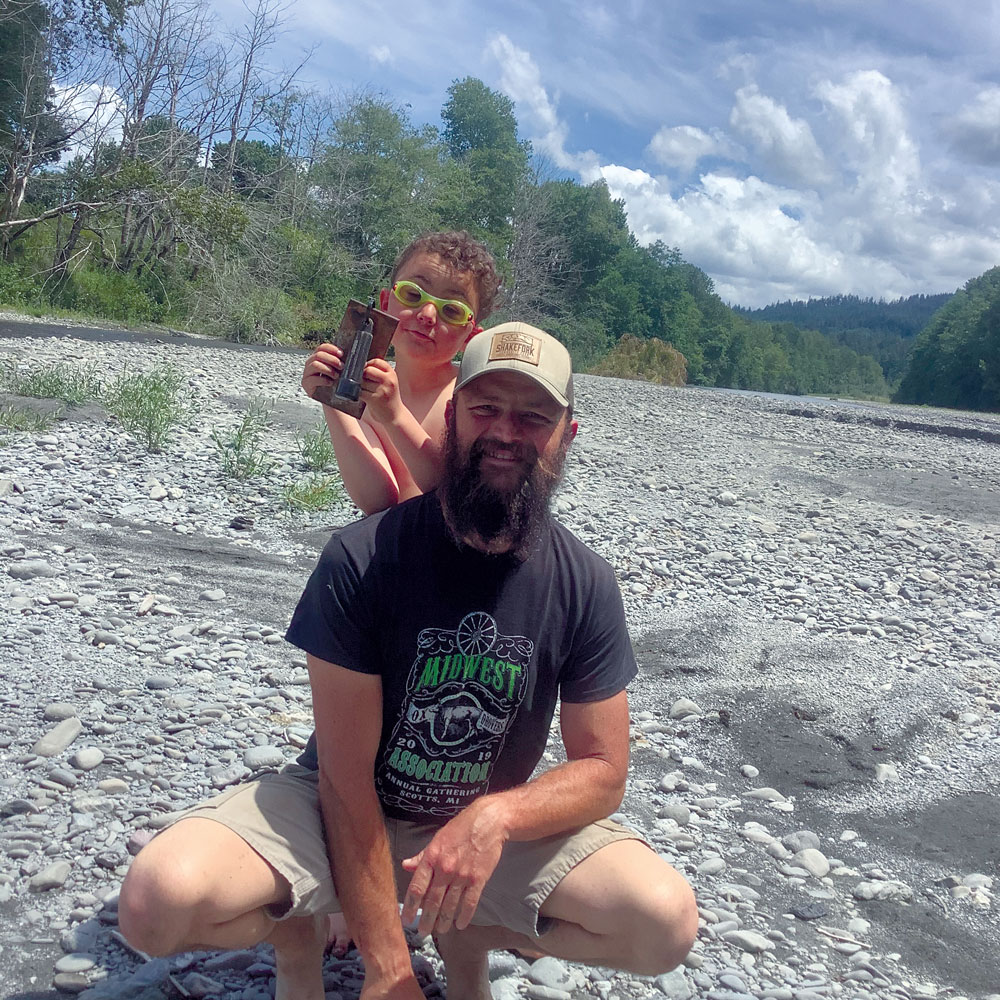
Photo by Sal Steinberg
Due to the pandemic, I was unable to complete my current Cereus Grant. Instead of going to schools this fall, I am now developing and sharing curriculum materials. Nurturing Nature consists of a 3-part series of lessons beginning with writing a paragraph Talking to Nature, drawing a picture of the Tree of Life, and writing a tree poem. Kahlil Gibran said, “Trees are the poems that the earth writes upon the sky.” These lessons can be found on my website www.fovd.org under Cereus Grant 2021.
Additionally, I have been exploring the Internet and found a phenomenal video series for students in kindergarten through 8th grade. Called Generation Genius, it offers engaging and creative lessons in science and math. Check out the website www.generationgenius.com. Lessons are divided into three grade levels: K-2, 3-5, and 6-8. Cost is only $175 per teacher with an automatic renewal each year. There is a free trial period.
After discussion with the Trees Foundation, we decided to use the remaining funds from the existing grant during the rest of the 2021-2022 school year. Thank you, Trees Foundation and the Cereus Fund.
Friends of the Lost Coast
The Cereus Fund of Trees Foundation has long been a supporter of Friends of the Lost Coast (FOLC). Where as past grant awards have largely focused on our invasive plant removal and native plant restoration programs on the Lost Coast, in 2021 funds were awarded to assist with administrative staffing and to enhance our website and social media presence.
FOLC is in a time of transition, both organizationally as we shift from being exclusively Board-run to an organization with paid staff, and in relation to COVID-19, as public-gathering restrictions and school closures required us to bring more of our programs online into the virtual space. Our most recent grant from the Cereus Fund was used specifically to help us in these newly challenging areas. This made it possible for us to pay a professional webmaster and to create a page on our website to house the in-school environmental education curriculum lessons for one of our seminal programs, The Lost Coast Environmental Education Resource (LCEER), which FOLC administers on behalf of the Bureau of Land Management. Traditionally these lessons are taught in local schools by our LCEER educators, but COVID-19 made this impossible in the 2020/21 school year. The Cereus Fund of Trees Foundation enabled us to upload the curriculum and lessons directly to our website, allowing teachers and students to access the materials and incorporate them into distance- and pod-learning plans without our educators entering a classroom.
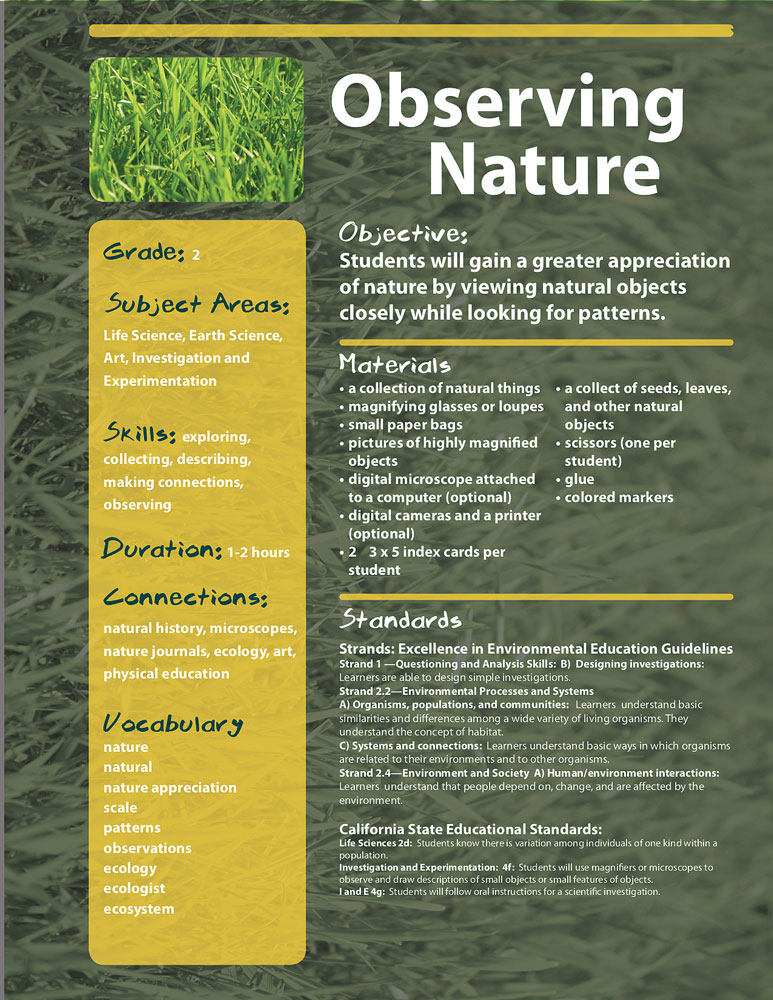
“Observing Nature” is one of more than 62 natural science lessons now available at lostcoast.org for teachers, students, and anyone interested in learning about the natural life of the Lost Coast and beyond. All lessons meet STEM standards.
Additionally, the Cereus Fund grant was used to support the ongoing work of a new Administrative Director, allowing for increased hours to maintain and keep current the events calendar on our website and to assist our webmaster in ensuring that content is complete and accurate. The Administrative Director worked closely with our webmaster to overhaul the website, lostcoast.org, and to assemble the content/ images necessary to complete the project and make it look great. Our Cereus Fund grant also supported our Administrative Director in building and maintaining FOLC’s social media presence, more widely promoting our upcoming educational and volunteer stewardship opportunities. Furthermore, the Cereus Fund grant was used in developing and implementing organizational policies to ensure that our programs—and the funds that support them—are well tracked, accounted for, and managed.
Many thanks to The Cereus Fund of Trees Foundation for their continued dedication to the work and mission of Friends of the Lost Coast, as well as their support for many other environmental organizations working to bolster grassroots perseverance and resiliency in the redwood region.
Humboldt BayKeeper
Mercury Study Expanded to Include Ocean-Caught Fish Species
In the second phase of Humboldt Baykeeper’s mercury study, we sampled 70 ocean-caught fish, including Pacific Halibut and several species of rockfish, from nearshore waters off Cape Mendocino, Sumeg Village, and Reading Rock. These fish were caught by Jeffery Stackhouse, a licensed fishing guide, and by Ross Taylor and Associates (RTA), a consulting fisheries biology firm. (see FRN Winter 2017, page 20 , https://tinyurl.com/6ce3kuf4 for info on phase one)
Eating fish has health benefits—as long as it is low in mercury, which tends to concentrate in bigger, older fish. Low-mercury fish is high in omega-3 fatty acids, vitamins A, B, and D, and is a good low-fat source of protein. But knowing which fish are low in mercury isn’t always easy.
At lower levels of mercury consumption, symptoms can include fatigue, muscle and joint pain, memory loss, and numbness or tingling around the mouth. At higher levels, symptoms include loss of coordination, numbness or tingling in the hands or feet, blurred vision or blindness, hearing loss, and speech impairment.
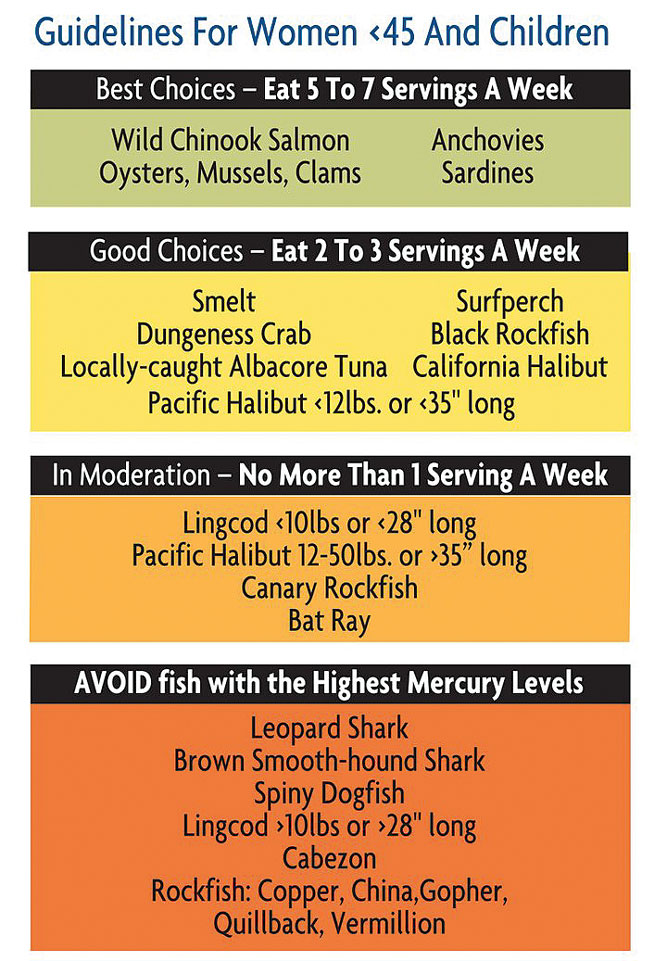
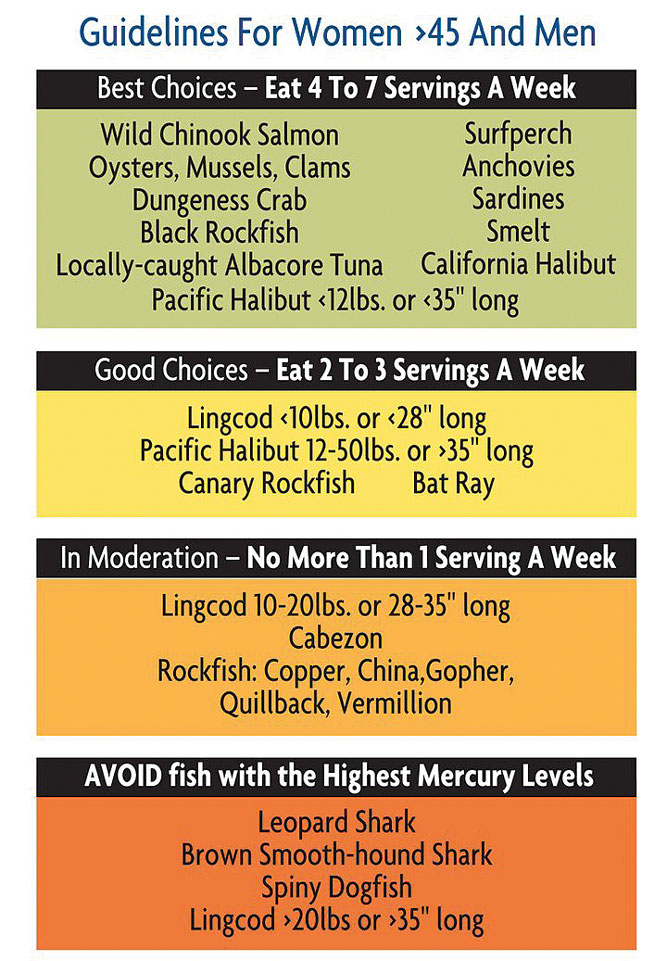
During our 2018 study, we interviewed 80 fishermen, including one from Shelter Cove who suffered mild health effects from elevated mercury levels. He developed symptoms after eating local rockfish 3-4 times a week. Within three months of changing his eating habits, his mercury levels decreased.
The U.S. EPA sets lower levels of mercury exposure for children and women of child-bearing age (under 45) than for men and women over 45. Women planning to get pregnant should lower their mercury exposure by eating low-mercury fish and shellfish.
The good news is that many of the fish caught in Humboldt Bay and nearshore coastal waters have low to moderate mercury levels. However, Lingcod over 10 pounds or 28” long, Pacific Halibut over 50 pounds, and some rockfish species should not be consumed by women under 45 and children, whereas Lingcod under 10 pounds are safe to eat once a week. Leopard Shark and Lingcod over 20 pounds should be avoided by everyone, regardless of age and gender. They are long-lived predators that eat high on the food chain.
Tips for choosing low-mercury fish are to focus on mostly smaller, younger fish or shellfish like crabs, oysters, clams, and mussels. When eating fish from a store or a restaurant, one serving of fish per week is a good general rule, unless you know it is high in mercury (in which case, don’t eat it at all).
Our final report and factsheets are available on our website:
www.humboldtbaykeeper.org. Thanks to the Cereus Fund of Trees Foundation, California EPA, and the Humboldt
Area Saltwater Anglers for supporting this project!
Mid Klamath Watershed Council
Summer Adventures in the Mid Klamath
The Mid Klamath Watershed Council (MKWC) recently wrapped up a successful summer of youth programs, and we have much to be proud of. The season began with a potent mix of ambition and caution as we envisioned a summer full of activities while preparing for them to change or be cancelled at any moment. Miraculously, we were able to attain all our goals, with full participation from more than 30 campers and junior counselors. We thank the Cereus fund for contributing to this worthwhile program.
Rather than our standard weeklong overnight experience, we adapted to offer an epic sequence of single-day events affectionately known as KAOS (Klamath Adventure Outdoor Series). Every Thursday we invited 13 kids and several presenters to a different natural site and provided a full day of outdoor recreation, hands-on science, and social connection, all free for local youth.
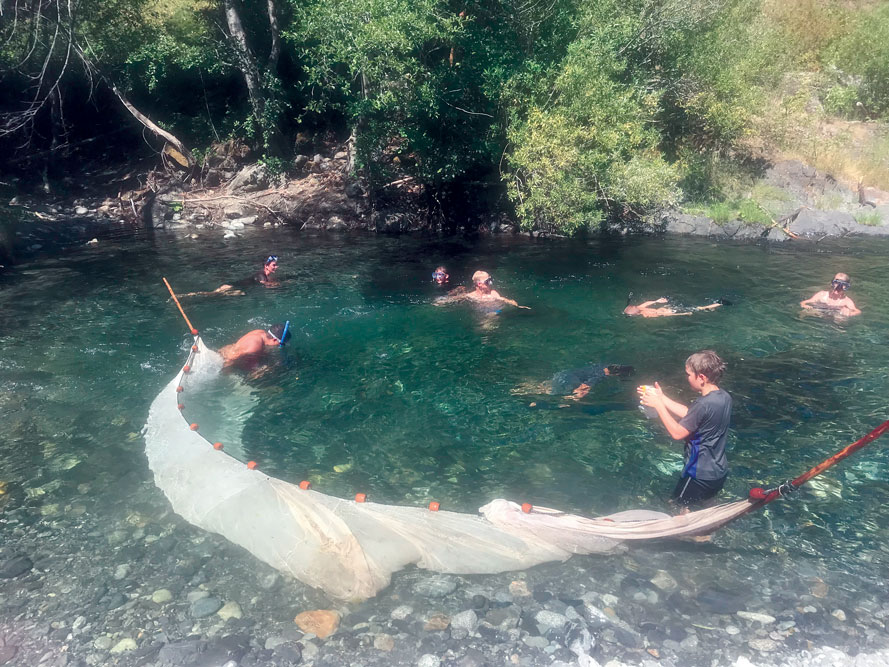
of the Karuk Tribe Department of Natural Resources Fisheries.
Photo courtesy MKWC
From the high-mountain meadows and wilderness lakes, to the cool creeks and rapids of the Salmon and Klamath rivers, we ventured out in tubes, kayaks, and drift boats to learn from and engage with our watershed. Water-based play was integrated with our environmental stewardship curriculum, covering topics such as fire safety, invasive plants, salmon refugia, conifer diversity, and water conservation.
We incorporated arts and crafts, solar-oven cooking, and life skills such as catching, cleaning, and cooking your own fish. We closed each day with a time for reflection, circling up to share our favorite memories, more difficult moments, and how we would like to improve ourselves and the world around us.
For our final event of the year, we took the kids camping in the Trinity Alps. Activities included day-hiking to two beautiful lakes, nature journaling, and games through which we learned about predator/prey relationships and nocturnal animals. Several families accompanied their campers and learned alongside them how to pack, trek, stay safe, and have fun in the wilderness. These lessons were of particular value as a thunderstorm rolled across the ridgeline, bringing rain and sparking the first wildfires of the season within our river basin.
As the curtain closed on our summer events, we held one final circle of reflection, each member expressing gratitude and amazement at all we had achieved in the face of so many shifting factors. Together we had navigated intense weather, pandemic precautions, and balancing the unique needs of each participant, our community, and the environment. Our efforts were rewarded by rich educational experiences and deeper connections to one another and this extraordinary place.
Mattole Restoration Council
By Ali Freedlund
The Forest Practices Program of the Mattole Restoration Council has been busy this year following the activities of the Humboldt Redwood Company (HRC) and advocating for healthy land stewardship.
Humboldt Redwood Company is the largest industrial timber company in the Mattole River watershed. Since March there have been two HRC timber harvest plans proposed in the Mattole, and the Forest Practices Program submitted comments throughout the process on both. The first, THP 1-21-0031, is in the Petrolia area, nearby a residential neighborhood. Many concerns were raised with this plan that is accessed via a blind one-lane slide area used by residents. Other concerns include: road building within the riparian zone of McGinnis Creek, more than 3000 feet of new road construction, the harvest of older trees currently providing slope stability and resilience to wildfire, and the almost-clearcut forestry practices using Variable Retention. Nonetheless, the plan was approved.
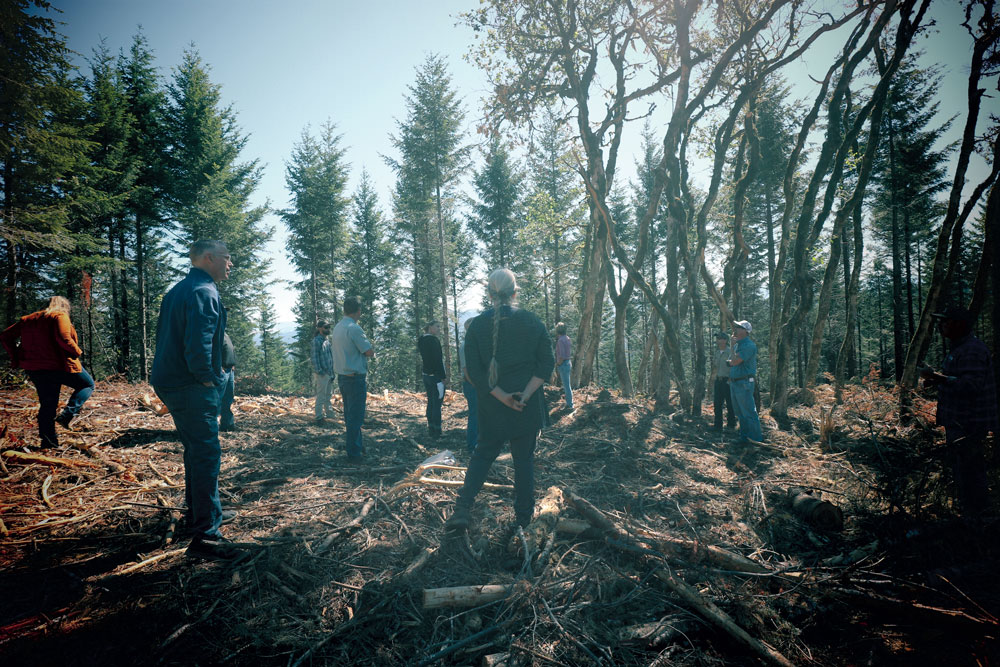
photo by Eleonore Jordan Anderson
Variable Retention (VR) requires retaining a small percentage of standing trees within each unit and is often justified as necessary to promote Douglas-fir regeneration. Yet, VR is classified as uneven-aged forestry. As a backstory, when the owners of HRC purchased former Pacific Lumber Company (PL) land, one of the positive changes was that HRC was dedicated to uneven-aged harvest practices as opposed to the outright clearcuts that PL was infamous for as part of its even-aged practices. Unfortunately, VR harvests end up looking almost like a clearcut. Standard timber industry opinion is that Douglas-fir will not grow in the canopy of older trees. My experience says differently, and there is now research to prove it with the amazing work of Suzanne Simard, who has introduced to the scientific world the idea of Mother trees. From her research we know that elder Douglas-fir trees share food and resources with youngster trees. Check out her book Finding the Mother Tree: Discovering the Wisdom of the Forest if you haven’t already. Or you can read about it here: https://mothertreeproject.org/about-mother-trees-in-the-forest.
The second HRC plan proposed in the Mattole this year, THP 1-21-0107, is in the Rattlesnake and Fox Camp drainages. Concerns include 4500 feet of new road construction, harvest near a spotted owl, harvest of older Douglas-fir, harvest near headwater streams, harvest close to Humboldt Redwoods State Park, and some harvest using VR.
Meanwhile, I was graciously invited on a field day in July with Congressman Jared Huffman. The tour went to an HRC fuels-reduction demonstration project and a meet-and-greet proposed oak woodland prescribed burn project facilitated by Humboldt Prescribed Burn Association.
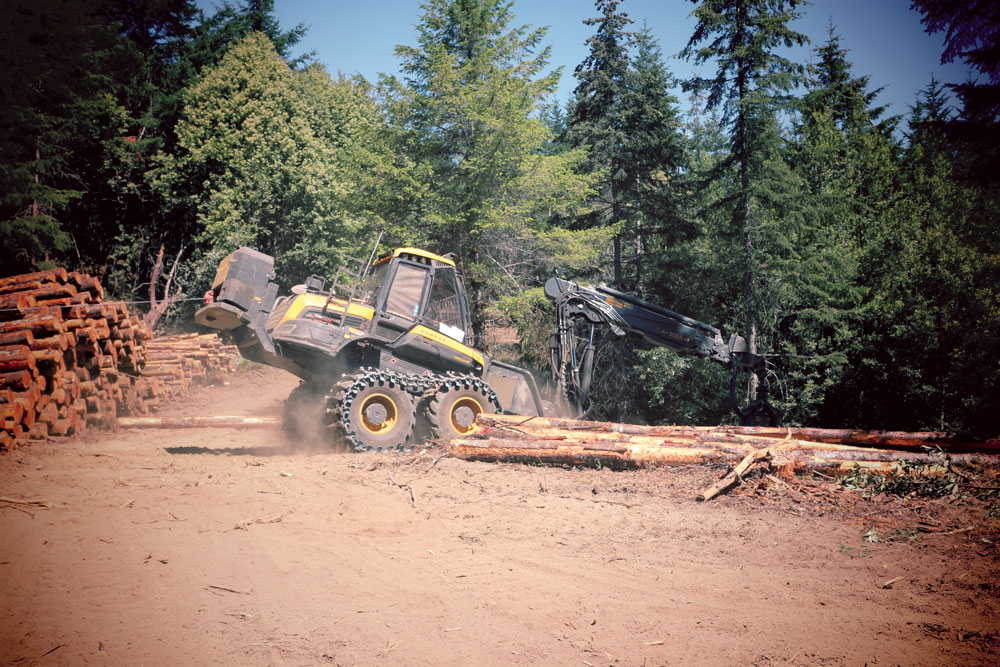
photo by Eleonore Jordan Anderson
At the HRC site, we witnessed a mammoth piece of heavy equipment known as the Ponsse. This beast (see photo above) was created for multiple uses, with the ability to be used on steep slopes. The head of the machine can saw down a tree, de-limb it of branches, and cut it into pre-programmed lengths. The Ponsse was rented with a crew as part of a grant-funded project through North Coast Resource Partnership. Until now HRC had not accepted grant funding for management that I knew of for their forests, but I think it is a good and necessary thing, as HRC lands include so much logged-over, dense second- and third-growth forests to treat in order to nourish resilience from wildfire and disease. HRC is exploring ways to reset their large forest stands for a healthier future…until they harvest again, that is. HRC’s Oak Woodlands treatment part of the project is shown in the photo on page 15, bottom left.
The tour ended at a private landowner’s oak woodland that will have prescribed fire through Humboldt County Prescribed Burn Association. The majestic old oaks were a delight to behold and definitely held an imaginable healthy future. Thank you to Cereus Fund of Trees Foundation for all your support.
Mattole Salmon Group
Every summer since 1996, volunteers have snorkeled the Mattole River to search for summer-run steelhead, the rarest of Mattole salmonids. Every year, that is, except for 2020, when COVID made the always complicated puzzle of vehicle shuttling impossible. We were happy to be back in 2021, with financial support from Trees Foundation’s Cereus Fund, the Conservation Lands Foundation, and the Bureau of Land Management (BLM).
Summer-run steelhead enter freshwater in spring and spend the summer hiding out as flows drop and temperatures increase, before spawning when rains come again in the fall. In 25 years, no more than 56 adults have been seen in a year; in contrast, estimated annual returns of the more numerous winter-run steelhead are 2,000–5,000 adults.
In 2021, 15 adult summer-run steelhead were seen, a bit less than the average of 22, but more than the seven adults observed in 2019. There are many things we don’t understand about these fish. While it is clear the adults need deep pools, preferably with a cool water source and some cover, what drives year-to-year variation in abundance, where in the watershed they spawn, and the degree to which they are a genetically distinct run remains a complete mystery.
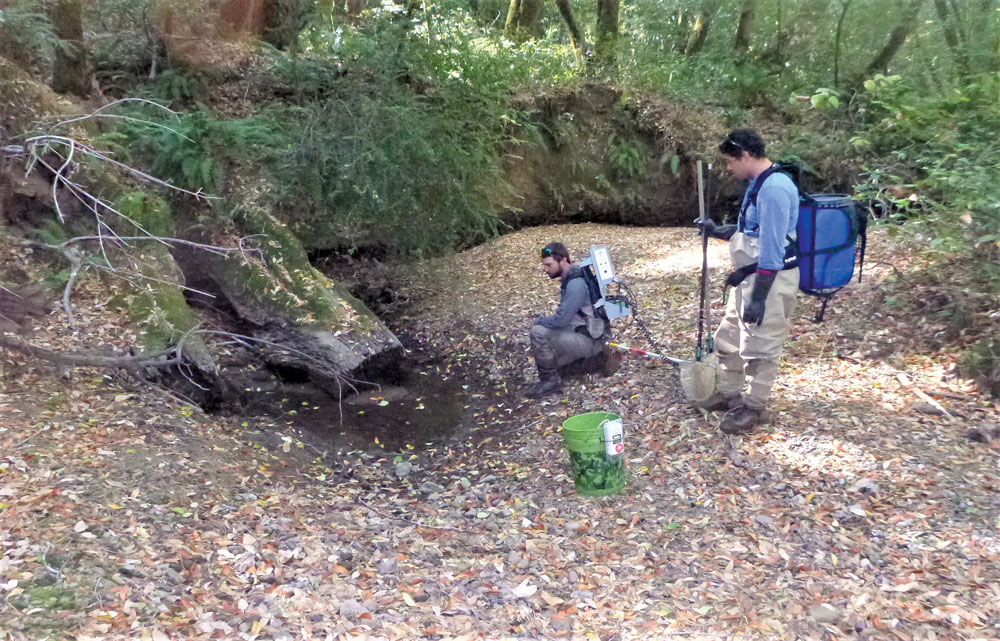
photo courtesy MSG
We are working with Dr. Samantha Kannry and BLM staff on research that should help us better protect these creatures. In 2020 and 2021 we collected several hundred caudal (tail) fin clips from juvenile steelhead, captured using dipnets in streams throughout the watershed. Dr. Kannry is analyzing these samples using techniques employed in her PhD research in the Eel River, where she found summer-run genotypes predominant upstream of flow-dependent barriers (boulder roughs) in the Middle Fork Eel and the Van Duzen, and winter-run genotypes predominant below these barriers. The Mattole lacks large barriers such as these, and geographically is more like the South Fork Eel, from which there were no summer-run genotypes detected at all!
Support from the Cereus Grant of Trees Foundation also allowed us to snorkel 638 pools counting juvenile coho salmon. This was the best year for coho in over a decade, with an estimated abundance of nearly 6,000 coho parr (juveniles), well above the average of 1,800. Unfortunately, by late August many of these fish were stranded in drying pools. Thanks to the assistance of CDFW biologist Chris Loomis, we were able to move more than 2,000 coho and steelhead to wetter waters, but this summer was a sobering reminder that in the face of climate change these fish need every advantage to survive.
Restoration Leadership Project
The main and continuing goal of the Restoration Leadership Project is to solve environmental problems by unifying people to bring about lasting positive change in land management attitudes and practices. Some of the work in 2021, under COVID-19 constraints, included:
• Continued active engagement with Redwood Forest Foundation and Usal Redwood Forest (RFFI/URF) and the surrounding communities. Significant efforts are underway to bring Northwest Mendocino County first responders and fire departments into contact and communication with landowners to improve emergency capabilities and understanding, as well as to encourage participation by all parties in long-term community, resource, environmental, recreational, and social well-being. Some of the major landowners are RFFI/URF, State Parks and Recreation, Intertribal Sinkyone Wilderness Council, Lost Coast Forestlands, Bureau of Land Management, and Save-the-Redwoods League. Some of the emergency/first responders/firefighters are located in Whale Gulch, Whitethorn, on BLM property (King Range), Westport, Leggett, Piercy, Garberville, and Briceland.
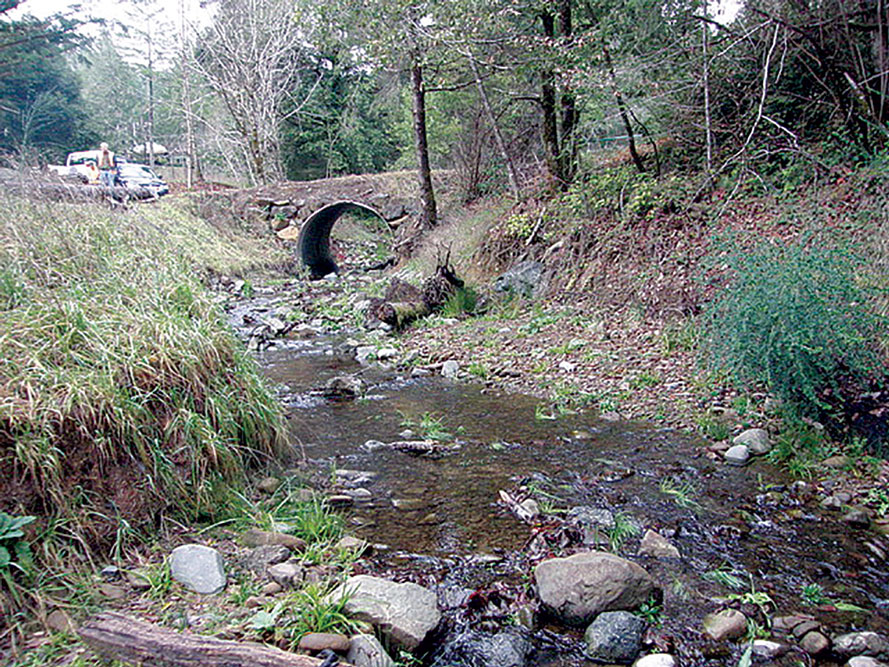
photo by Richard Gienger
• Other continuing work is furthering application of Indigenous Traditional Ecological Knowledge in the recovery of the forests and watersheds in Northwest Mendocino County. There is a renewed interest and involvement by local Tribes in the restoration of the Chinquapin Tan Oak Grove and a variety of other reconnection–stewardship projects.
• Arduous efforts continue with Forests Forever and Why Forests Matter to reform and bring about industry practices that will ensure long-term high-quality forests. This is especially difficult because the catastrophic fires have focused actions on reducing the forests without having standards in place for long-term high-quality and fire-resistant forests, which is claimed to be the goal. The scale, utility, and reform measures of the Planning Watershed Pilot Project approach are being bypassed as California moves to hyper-large-scale projects that leave forest-based communities in the lurch. California is pushing unrealistic technological “climate fixes” that highlight efforts to combat climate change by burning small thinned trees in biomass facilities and piping all the massive amounts of CO2 produced into underground strata. The Leadership Project speaks out regularly
in multiple venues and on webinars/Zoom meetings, often several times per week, to persistently advocate reforms that will benefit both forest and
human communities.
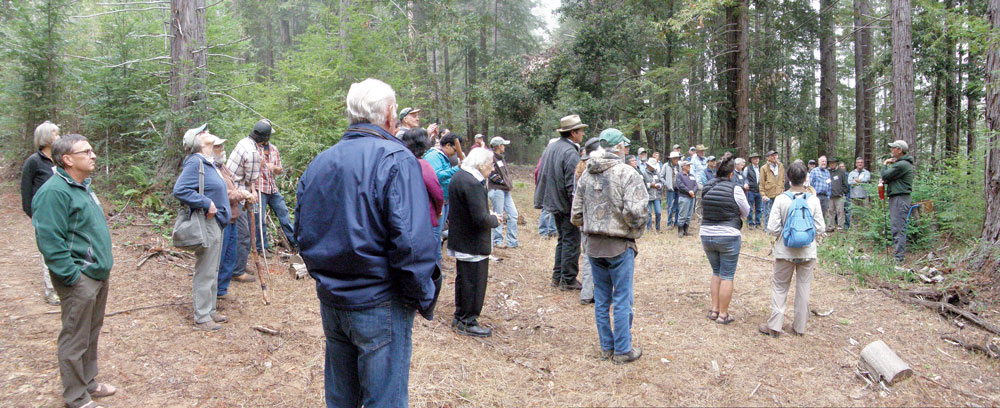
photo by Richard Gienger
• A major focus and fulcrum for change is the effort to pressure Jackson Demonstration State Forest (JDSF) to impose a two-year moratorium until reform and transparency and public engagement can set adequate standards given the dire climate conditions to adequately take the right actions—to not only set forest stewardship right in JDSF, but for all California forestland.
• Monthly Monday Morning Magazine shows on KMUD with co-host Jeff Hedin and several Institute for Sustainable Forestry (ISF) radio specials every month bring guests with positive experiences and perspectives to a broad audience. Outstanding forest and watershed activists, professionals, scientists, and community leaders are constantly brought forward for inspiration and exemplary pathways. Forest & River News is also key.
Trees Foundation’s Cereus Fund makes so much of this work possible. Thank you.
Sanctuary Forest
Working Collectively Across Watershed Boundaries
Sanctuary Forest’s water stewardship goal is to develop land and water stewardship programs with partners to keep the Mattole River flowing and healthy. Low streamflows and the prolonged drought have severely impacted Mattole River salmonids. Water quantity issues have also affected residents who depend on the Mattole River for their everyday needs. To that end, Sanctuary Forest continues to implement salmonid habitat restoration projects and to work with our community to create a culture of water conservation through education and outreach. There is an urgency to address climate change and a need for direct actions to create a more drought-resilient landscape. This is not a light undertaking and not one that we can address alone. This work requires an immense amount of collaboration with our watershed partners, Mattole Salmon Group and Mattole Restoration Council, and with partners outside our watershed, notably the Salmonid Restoration Federation (SRF).
Sanctuary Forest often collaborates with SRF, and in 2021 we participated in two SRF-hosted workshops/events. On Saturday, May 8, Sanctuary Forest co-hosted a virtual workshop to explore evolving restoration techniques in Redwood Creek and the Mattole River: Evolving Restoration Practices in an Era of Climate Change: The Intertwined History of Two Connected Watersheds. More than 50 participants joined the workshop to learn about land use history, water storage, coho straying, restoration priorities, low flow monitoring, and
flow enhancement.
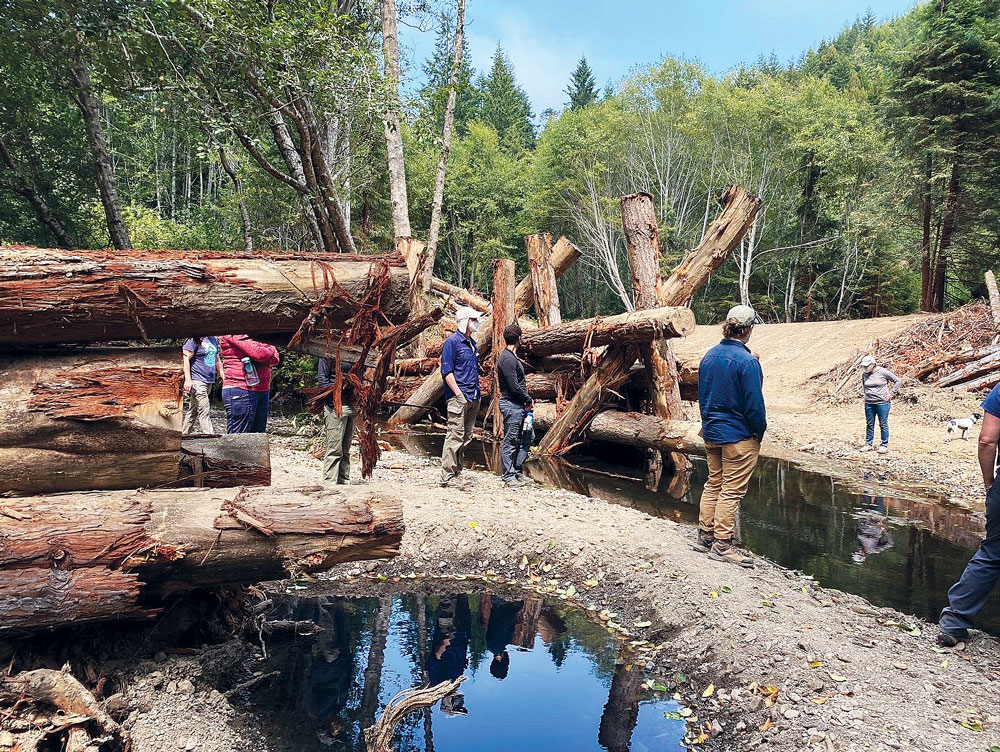
photo courtesy Sanctuary Forest
In August, Sanctuary Forest staff travelled to the Navarro River watershed to attend the 23rd Annual Coho Confab. Tasha McKee, Sanctuary Forest’s Water Program Director, presented Community Water Programs and Flow Lessons Learned in the Mattole. Other restoration partners including The Nature Conservancy and Trout Unlimited also presented on their efforts to work with the community to restore streamflows and led tours of restoration projects taking place in Mendocino County.
Sanctuary Forest works with multiple partners to develop solutions to water scarcity issues, share knowledge, and raise awareness throughout the greater North Coast region. Special thanks to The Cereus Fund of Trees Foundation for granting funds to support these efforts to restore balance for the benefit of fish, wildlife, and people.
Salmonid Restoration Federation
Nordic Aquaculture Research, Tracking, and Public Comments
Trees Foundation’s Cereus Fund grant helped Salmonid Restoration Federation (SRF) track, research, and submit public comments regarding the Nordic Aquafarms (NAF) proposed Samoa land-based aquaculture project on the Samoa Peninsula. SRF’s work focused on participating in NAF’s community outreach meetings (called “office hours”) and initiating discussions regarding potential fish diseases from farmed salmon and toxicants in commercial fish feed. SRF is concerned that NAF would raise Atlantic salmon since SRF is focused on preserving wild populations of salmon on the North Coast. We are strongly opposed to genetically modified salmon and the risks associated with discharge and effluent in land-based aquaculture operations.
Fish food for Atlantic salmon consists of 7–10% fish oil and 7–10% marine meal, which means that 14–20% of the proposed feed sourcing will be from wild fish that support marine ecosystems outside the project area. In this instance Pacific herring is the likely fish food source, which would take away significant food resources from wild salmon in the Northwest.
During public meetings and in SRF’s public comments, we expressed our concern about the proposed operation’s toxicity, discharge, effluent, and carbon footprint. SRF staff and Board reached out to HSU faculty, Norwegian researchers, UC Santa Cruz fisheries faculty, staff from Save Our Salmon, and Humboldt Baykeeper in order to do comprehensive research and compile technical documents that informed our public comment letters. Additionally, we coordinated with local salmon and crab fishermen, Golden State Salmon Association, Pacific Coast Federation of Fishermen’s Associations, California Coastkeeper Alliance, Sierra Club, and Pacific Fisheries Management Council.
Specifically, SRF worked with staff and students at Humboldt State University and University of California Santa Cruz to share analyses and ensure that all adverse effects to salmonids were addressed during public scoping. SRF worked with Save California Salmon and provided a set of preliminary exposure analyses for Project effluent discharged or flowing into Endangered Species Act critical habitat for five species.
SRF also coordinated with California Department of Fish and Wildlife staff to address project effects on coho salmon and longfin smelt in Humboldt Bay. As an important forage fish for salmonids, longfin smelt productivity is important for salmonid growth and survival.
SPAWN
Thanks to help from a grant from the Cereus Fund of Trees Foundation, Salmon Protection and Watershed Network (SPAWN) was able to train, house, and utilize several full-time interns for six months or longer in 2021, including a diverse group of folks who came to Marin County, California from such far-away places as New Hampshire and Texas.
Jamie Wilson (Manchester, NH), Teska Hapig-Ward (Sonora, CA), Matt Fernandez (Pasadena, CA), and William Benedict (Long Island, NY) interned for six months, while Logan Anderson (Davis, CA) and Eleanor Clarke (Houston, TX) extended their internships to nine months, gaining additional training and experience at increased levels of responsibility.
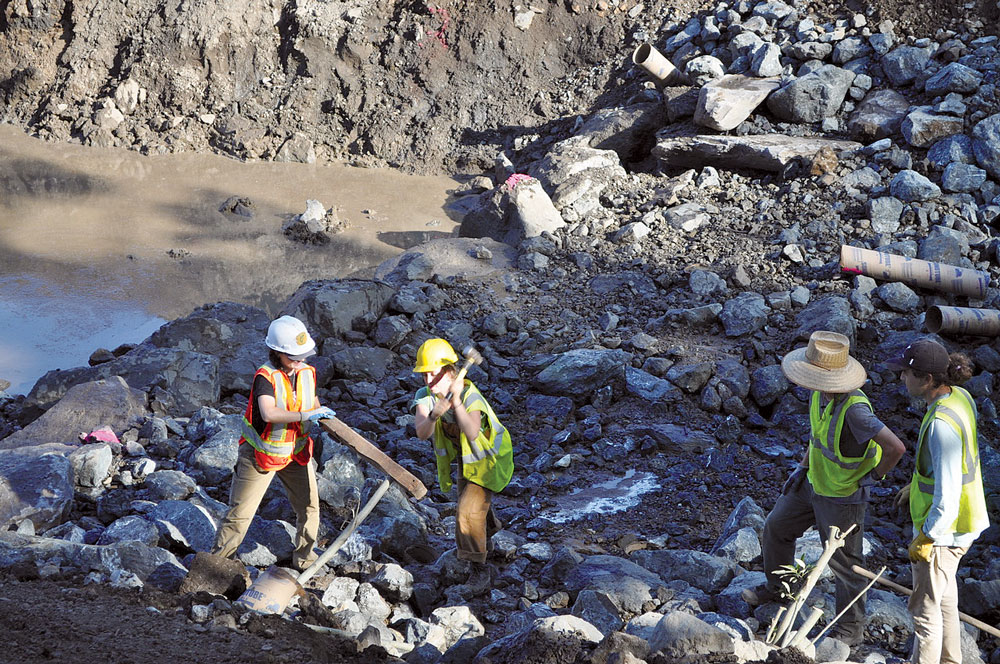
photo courtesy SPAWN
Interns were trained and gained valuable hands-on experience in techniques and methods of stream habitat restoration, bio-technical stream stabilization, topography surveys, wildlife habitat surveys, salmonid spawning surveys, juvenile salmon monitoring and handling, native/invasive plant identification and removal methods, native plant propagation, horticulture, seed collection and sowing, plant nursery operations, irrigation installation, erosion control measures, public outreach and communications, public speaking, grant-writing, project management, event planning and preparation, volunteer leadership, GIS mapping, and use and maintenance of small gas-powered equipment (chainsaws, brush cutters) and hand tools.
Intern Logan Anderson said, “The SPAWN internship program gave me invaluable hands-on experience for working in restoration and natural resource conservation. The staff was very supportive and worked to make my internship one that developed my skill set and cultivated my personal interests in conservation.”
In total, these interns collectively gained 5,280 hours of experience and provided a massive amount of human power to fuel our efforts. The value of this effort translated into $132,000 of volunteer labor, greatly amplifying the grant from Trees Foundation’s Cereus Fund and helping us to meet some of CA Fish & Wildlife Fisheries Restoration Grant Program “in-kind match” grant requirements.
According to intern Teska Hapig-Ward: “The internship program with SPAWN provided the invaluable opportunity to tackle climate issues and the effects on fish populations with a focus on hands-on work. By working with SPAWN, I solidified my interest in climate and wildlife science, learned about fish biology and habitat restoration by working directly with the animals, and was given opportunities and resources to tackle any personal projects I found interesting. SPAWN’s program was an integral step in my development as a wildlife biologist, habitat restoration technician, and climate activist.”
Our “graduates” have moved on to various natural resource positions including with the National Park Service, Environmental Science Associates, U.S. Forest Service, and Outward Bound.
“The insight and human power provided by our interns is a big part of the engine that makes SPAWN so efficient and effective,” said Watershed Conservation Director Preston Brown. “Interns bring new insights to our work, and we love learning from them as well as teaching.”
Trees Foundation’s Cereus Fund grant was used to cover housing and equipment costs such as utilities, maintenance, internet services, and protective gear.
Tenmile Creek Watershed Council
The Tenmile Creek Watershed Council (TCWC) was formed in 2018 after a series of public meetings in Laytonville, California. Attendees voiced concerns about declining salmon population, loss of flow in local creeks, the health of native oak woodlands, and the threat of wildfires. The Council partnered with the Eel River Recovery Project (ERRP) to propose a watershed restoration and conservation program. Grants targeting streambank restoration and forest health are currently being applied for and administered by ERRP. For TCWC the challenge is how to efficiently disseminate information about projects already underway and how individuals can become involved.
Due to COVID-related restrictions on gatherings of any kind, a video offered a solution. It could be shown at small gatherings, made available online, and distributed to schools. TCWC applied for and received a couple of modest grants, including a Trees Foundation Cereus Fund grant allowing us to look for someone capable of making a quality product.
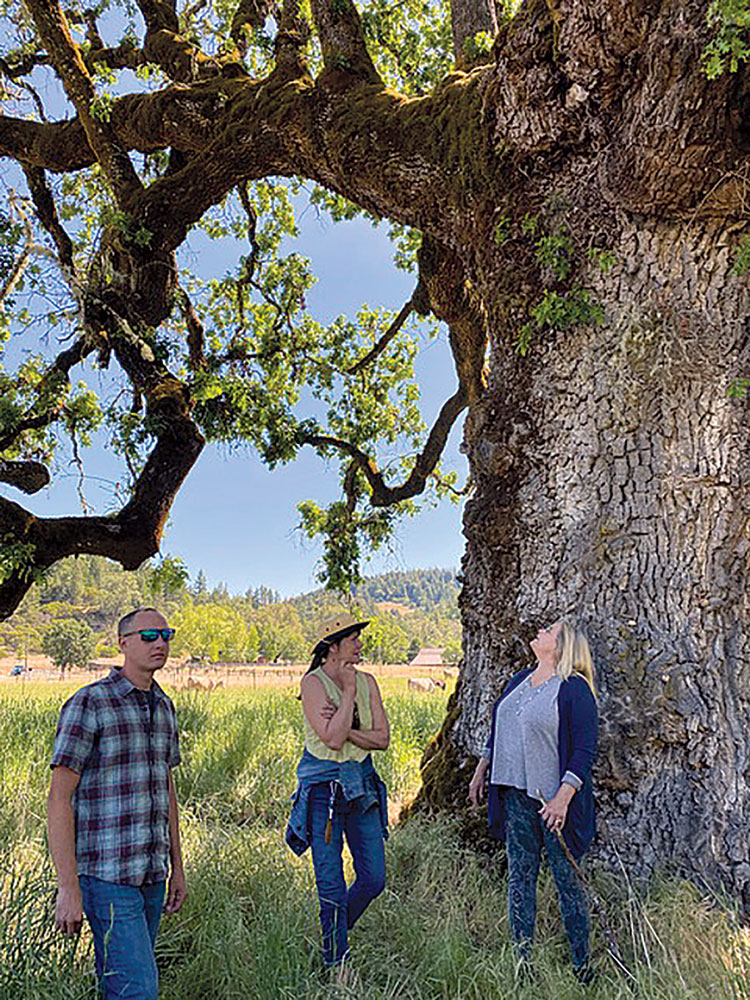
photo by Alison Pernell
Of the five TCWC board members, four are local property owners with a variety of land issues and one works at BioEngineering Associates. The arc of the video highlights current projects, including streambank restoration, oak woodland restoration and fuel removal, erosion control, grassland restoration/noxious weed removal/controlled burning, and efforts to bridge a wet crossing on Tenmile Creek. Others interviewed include a Cahto Tribe member and environmentalist bringing a Native perspective, and a project manager with the Natural Resource Conservation Service (NRCS) explaining Environmental Quality Incentives Program grants for landowners.
Obstacles arise when completing any project; in this case, COVID and wildfires have slowed progress. Everyone’s time is voluntary, including the videographer and his assistant since their stipend is far below cost. Merely finding the time to meet can be a challenge. In late spring we set aside two days for the bulk of the shooting, which required calm, clear weather. The five board members with the videographers and all their gear set up at a variety of locations. The NRCS and Cahto Tribe interviews occurred on separate days. The storyboard calls for an aerial shot following Tenmile Creek as it runs northward through Long Valley featuring native oak woodlands and riparian vegetation. When a local pilot donated his time, a date was arranged for a flyover. But by the morning of the shoot, smoke from the California wildfires created a yellow haze over the valley and we had to abort as we stood on the runway. Next, a vaccinated crewmember tested positive for COVID. But determination prevails, the long-awaited shoot will take place, the footage will go to the editor, and by spring our video will be available to the public. (On Facebook: Ten Mile Creek Watershed Council)
Women’s Forest Sanctuary
The Women’s Forest Sanctuary (WFS) continues to thrive. We learn and evolve through our connections with the forest and our community of forest allies. We are grateful for our conversations with Hawk Rosales of The Intertribal Sinkyone Wilderness Council, which inspire us to listen to trees with our whole being and to explore our interconnection with nature.
Our annual visit to The Sacred Grove included rejuvenating connections with friends and neighbors who participate in stewarding the land. Cathy Lentz, an ardent supporter, contributed breathwork and serene music, which enhanced the tranquility of our forest experience. At our community potluck dinner we enjoyed singing with live accompaniment and telling stories about protecting our forests.
In the shelter of the forest we welcomed feeling our grief for what’s happening in the world. We asked the trees, “How can we support healthy, vibrant forests?” We felt the trees silently holding us, teaching us about being steadfast in the face of loss. In opening our hearts, we became stronger in moving through grief and connecting with what we love.
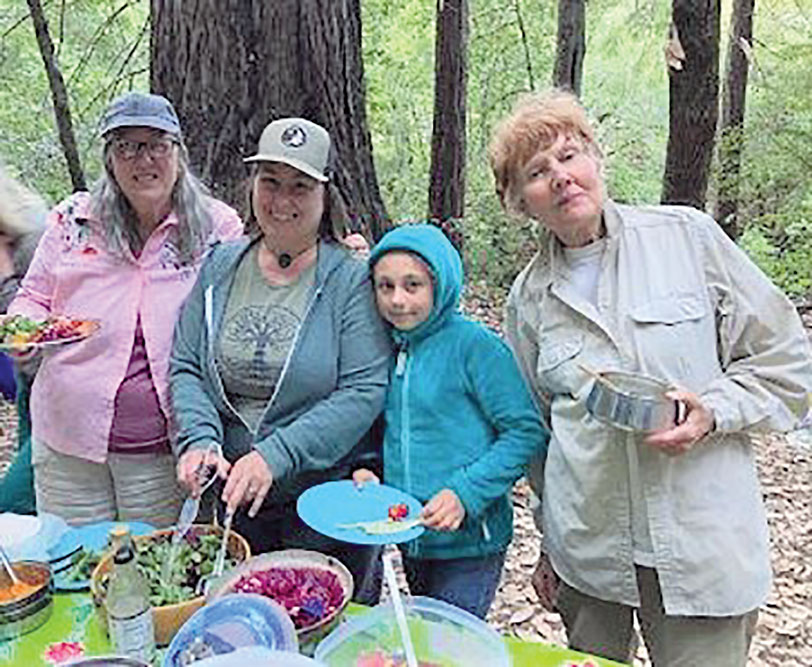
photo courtesy Women’s Forest Sanctuary
Our adventures with the land included waking up in the night to cries of wild cats and the earth quaking, discovering where a stream running under the grandmother trees joins the Mattole, and walking the property to assess tactics for fuel reduction.
Young participants at Youth Spirit Artworks (YSA) were eager to experience our annual outing to Redwood Regional Park in Oakland and to relax in nature. Several youth found that they felt calm and at peace when sitting solo with a redwood tree. They loved learning that trees communicate with and support one another! Youth and staff drew images about their forest experience. Eric wrote, “I feel the warmth of the sun on my face and think about connections with everything alive. Roots from my feet connect to a small tree in front of me; we bring life into the world in different ways.”
WFS is exploring how we will further support protection of forests and reconciliation with nature. As we listen for guidance, we are drawn to learn about and respect Indigenous peoples who inhabited the grove and Mattole watershed for thousands of years. Strengthening our connection with the local Indigenous community and supporting their traditional ways of stewarding forests holds deep meaning for us.
We are grateful to the Cereus Fund of Trees Foundation for supporting diverse environmental efforts that collectively benefit California’s North Coast web of life.
